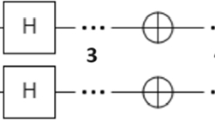Abstract
The aim of this paper is to present a thorough reassessment of the Snyman–Fatti (SF) Multi-start Global Minimization Algorithm with Dynamic Search Trajectories, first published twenty years ago. The reassessment is done with reference to a slightly modified version of the original method, the essentials of which are summarized here. Results of the performance of the current code on an extensive set of standard test problems commonly in use today, are presented. This allows for a fair assessment to be made of the performance of the SF algorithm relative to that of the popular Differential Evolution (DE) method, for which test results on the same standard set of test problems used here for the SF algorithm, are also given. The tests show that the SF algorithm, that requires relatively few parameter settings, is a reliably robust and competitive method compared to the DE method. The results also indicate that the SF trajectory algorithm is particularly promising to solve minimum potential energy problems to determine the structure of atomic and molecular clusters.
Similar content being viewed by others
References
Snyman J.A. and Fatti L.P. (1987). A multi-start global minimization algorithm with dynamic search trajectories. J. Optim. Theory Appl. 54: 121–141
Kam T.Y. and Snyman J.A. (1991). Optimal design of laminated composite plates using a global optimization technique. Compos. Struct. 19: 351–370
Kam T.Y. and Chang R.R. (1992). Optimal lay-up of thick laminated composite plates for maximum stiffness. J. Eng. Optim. 19: 233–249
Kam T.Y., Lai F.M. and Liao S.C. (1996). Minimum weight design of laminated composite plates subject to strength constraint. AIAA J. 34: 1699–1708
Chang R.R. (2001). Optimal design of laminated composite torque wrench. Comput. Struct. 79: 703–713
Lee C.R. and Kam T.Y. (2006). System identification of partially restrained composite plates using measured natural frequencies. J. Eng. Mech. 132: 841–850
Laskari E.C., Parsopoulos K.E. and Vrahatis M.N. (2003). Evolutionary operators in global optimization with dynamic search trajectories. Numer. Algorithms 34: 393–403
Greenspan, D.: Discrete Models. Addison-Welseley (1973)
Stillinger F.H. and Weber T.A. (1985). Computer simulation of local order in condensed phases of silicon. Phys. Rev. B 31: 5262–5271
Adler B.J. and Wainwright T.E. (1957). Phase transitions for a hard sphere system. J. Chem. Phys. 27: 1208–1209
Hockney R.W. (1970). The potential calculation and some applications. Methods Comput. Phys. 9: 136–211
Verlet L. (1967). Computer experiments on classical fluids. I. Thermodynamical properties of Lennard-Jones molecules. Phys. Rev. 159: 98–103
Snyman J.A. (1982). A new and dynamic method for unconstrained minimization. Appl. Math. Model. 6: 449–462
Snyman J.A. (1983). An improved version of the original leap-frog dynamic method for unconstrained minimization LFOP1(b). Appl. Math. Model. 7: 216–218
Ali M.M., Khompatraporn C. and Zabinsky Z.B. (2005). A numerical evaluation of several stochastic algorithms on selected continuous global optimization test problems. J. Global Optim. 31: 635–672
Storn R. and Price K. (1997). Differential evolution – A simple and efficient heuristic for global optimization over continuous spaces. J. Glob. Optim. 11: 341–359
Price K.V., Storn R.M. and Lampinen J.A. (2005). Differential Evolution: A Practical Approach to Global Minimization. Springer, Berlin
Ali M.M. and Fatti L.P. (2006). A differential free point generation scheme in the differential evolution algorithm. J. Glob. Optim. 35: 551–572
Wales D.J. and Doye J.P.K. (1997). Global optimization by basin-hopping and the lowest energy structures of Lennard-Jones clusters containing up to 100 atoms. J. Phys. Chem. A. 101: 5111–5116
Moloi N.P. and Ali M.M. (2005). An iterative global optimization algorithm for potential energy minimization. Comput. Optim. Appl. 30: 119–132
Ali M.M., Smith R. and Hobday S. (2006). The structure of atomic and molecular clusters, optimised using classical potentials. Comput. Phys. Commun. 175: 451–464
Snyman J.A. and Geerthsen K.A. (1995). The practical application of a dynamic search-trajectory method for constrained global optimization. In: Bestle, D. and Schielen, W. (eds) Proceedings of the IUTAM Symposium on Optimization of Mechanical Systems, pp. Kluwer, Dordrecht
Author information
Authors and Affiliations
Corresponding author
Rights and permissions
About this article
Cite this article
Snyman, J.A., Kok, S. A reassessment of the Snyman–Fatti dynamic search trajectory method for unconstrained global optimization. J Glob Optim 43, 67–82 (2009). https://doi.org/10.1007/s10898-008-9293-y
Received:
Accepted:
Published:
Issue Date:
DOI: https://doi.org/10.1007/s10898-008-9293-y




